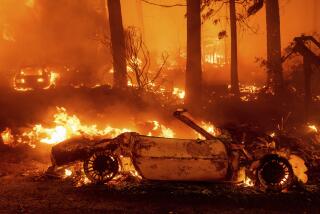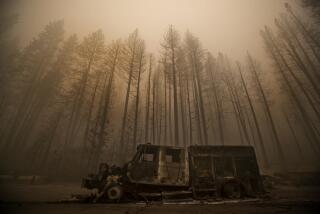See how a huge utility stonewalled regulators after its fatal pipeline disaster

The San Bruno gas explosion aftermath: eight dead, 38 homes destroyed.
The 2010 gas pipeline explosion in San Bruno, Calif., which killed eight people, stands as exhibit A for the incompetence of Pacific Gas & Electric, California’s biggest utility.
But not until now have we had a real window into the sheer juvenile arrogance with which PG&E executives handled government investigators looking into the blast.
PG&E employees, one official recalled, were “giggling, laughing...sarcastic...mocking...[and] offensive” when questioned by investigators for the National Transportation Safety Board, which was responsible for determining the causes of the disaster. They were “shady” and their answers “fishy.” Another NTSB investigator recalled an “ugly” and “toxic atmosphere” in his talks with PG&E. A third compared getting information from PG&E to “pulling teeth.”
It bears repeating: Eight people were dead.
See the most-read stories this hour >>
These details come from summaries of interviews of NTSB investigators conducted last year by federal prosecutors and others. The NTSB already had assigned almost all the blame to PG&E. The California Public Utilities Commission followed up with a $1.6-billion penalty, the largest it has ever assessed against a utility, by a substantial margin. By then federal prosecutors had indicted PG&E for, among other things, obstructing the investigation.
PG&E maintained in a statement it emailed us that it does “not believe that PG&E employees intentionally violated the federal Pipeline Safety Act” and that “even where mistakes were made, employees were acting in good faith.” The company restated its “goal to become the safest, most reliable energy provider in America.”
In the pipeline case, PG&E could be on the hook for $1 billion in criminal penalties, so this month it filed a motion with federal judge Thelton Henderson in San Francisco. The company included the investigative summaries as exhibits in its motion, partially to show that its alleged obstructions weren’t material to the probe. (A hat-tip is due Jaxon Van Derbeken of the San Francisco Chronicle for bringing the exhibits to light.)
What the summaries depict is a corporation with the blood of eight dead persons on its hands doing everything it could to browbeat and mislead government investigators. What’s worse, some of PG&E’s behavior reflects very badly on the PUC, where top officials have already been shown to have had an appallingly close personal relationship with PG&E higher-ups, which plainly interfered with their regulatory duties.
Consider PG&E’s treatment of a PUC engineer named Sunil Shori. Two NTSB regulators recalled separately a meeting or conference call in which Shori offered to travel to PG&E’s Walnut Creek offices to pick up some documents requested by the NTSB. They recalled that he was rebuffed dismissively by PG&E executive Brian Daubin, who said, “Nope. You cannot have them today. You’ll have to come tomorrow to get them” or “You can show up but you won’t get in.”
NTSB investigator Matthew Nicholson told prosecutors that he was “‘shocked’ at how PG&E talked to Shori, who was their regulator.” Another NTSB official who witnessed the exchange, Ravi Chhatre, said he asked Shori, “How can you take that from them?”
SIGN UP for the free California Inc. business newsletter >>
Chhatre recalled that Shori “acted a little embarrassed” but explained he had no power over PG&E. “Shori was afraid he would not get the support from his own managers.” Given what’s been learned since then about the coziness between his superiors and the PG&E brass, he might have been right. We sought comment from Shori, but he referred us to the PUC communications office, which hasn’t yet responded.
But that’s only one of the more colorful examples of PG&E’s arrogance elicited from the NTSB investigators. Nicholson concluded that the rot ran deep -- “there appeared to be a problem with the culture at PG&E,” he said, according to the summary of his interview. He cited a consistent “lack of cooperation and openness from the PG&E employees.” To Chhatre, “PG&E’s demeanor was “shocking and offensive.”
It would be tempting to chalk up the PG&E staff’s behavior to a frat-boy atmosphere at the company, but it was layered over serious issues of “shabby” record-keeping and dangerous operational practices, which preceded the San Bruno blast. NTSB investigator Robert Hall pointed to the company’s consistent disregard of regulations that were, after all, designed to keep pipelines safe. PG&E kept coming up with “creative” interpretations of the rules that aimed to “stretch the regulations.” He was quoted as telling the prosecutors, “Every rock you would turn over, you would find more problems.”
These disclosures are another indication that, as we put it in April, it may be “time to put PG&E out of business” by revoking its franchise and giving another company the chance to operate its infrastructure.
There are signs that the company’s safety performance, which long ranked toward the bottom of the utility industry, has gotten worse since San Bruno. The 2011 report of the PUC’s independent review panel on San Bruno suggested that management’s safety efforts were focused more on PR than a genuine devotion to safety -- its priority was “financial performance,” not “operational safety and performance.”
Perhaps PG&E has changed dramatically, but so far the evidence for that is mostly PR. The noxious culture is what stood out to the NTSB’s investigators, who had plenty of experience with utility toughness before running into the buzz saw that was PG&E. They came away shaking their heads in dismay.
This is a company that not only provides all utility service to almost everyone in Northern California but manages California’s only operational nuclear power plant. If PG&E staff couldn’t find it in themselves to act like grownups when its policies had caused the death of eight people and the destruction of an entire neighborhood, is there anything that would make them straighten up and fly right?
Keep up to date with the Economy Hub. Follow @hiltzikm on Twitter, see our Facebook page, or email michael.hiltzik@latimes.com.







